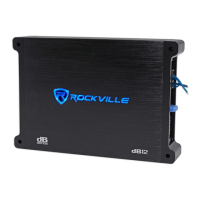10
The dB14, dB15, and dB16 can be bridged together for double the power output into a single 4-ohm load. Remember, when bridging
amplifers you must bridge them to a 4 ohm load.
Input the head unit signal into the MASTER amplifer and set the Bridged Mode switch to Output Master. Use a MONO RCA to RCA cable
to send the fully processed signal from the MASTER amplier to the secondary SLAVE amplier and set the Bridged Mode switch to Input
Slave. Do not input any RCA signals into the Slave amplier left and right inputs. All crossover controls, Bass Drive, frequency settings,
and subsonic lter settings will be controlled by the Master Amplier including input gain levels. There is no need to gain match the two
ampliers, it will occur automatically. The remote dash bass control should be plugged in to the Master amplier and it will control both
ampliers.
This same input/control system can be utilized when daisy chaining two amplifers to two independent 2 ohm woofers as long as you
don’tbridge the two ampliers outputs together.
You can only bridge 2 of the same amplifiers together. DO NOT bridge different models together.
When bridging two ampliers together, the nal impedance load of the bridged ampliers should be no lower than 4-ohms. Double power
will occur at 4-ohms. Master amplifers positive (+) speaker terminal should be wired to the positive terminal of the subwoofer.
Slave ampliers positive (+) speaker terminal should be wired to negative terminal of the subwoofer. Connect a heavy gauge wire (12 Gauge)
between the negative (-) terminal of the Master amplier and the Negative (-) terminal of the Slave amplier.
When daisy chaining two ampliers for independent woofers, wire up the the woofers as you would typically wire them when installing
individual systems, even down to 2-ohm. By using the Master/Slave input confguration you gain the advantage of having one amplifer’s
preamp section control both ampliers, eliminating the need to gain match and crossover match your system between ampliers.
Twin Amp Bridging

